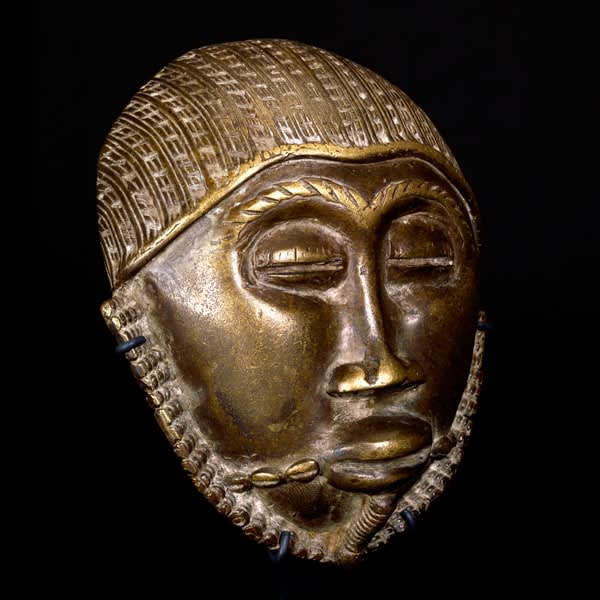Baule Bronze Mask, 1800 CE - 1900 CE
Brass- Bronze
4.5
DA.462
The Baule are one of the Akan peoples. They moved west to the Ivory Coast more than 200 years ago and adopted sculptural and masking traditions from their neighbors, the...
The Baule are one of the Akan peoples. They moved west to the Ivory Coast more than 200 years ago and adopted sculptural and masking traditions from their neighbors, the Guro, Senufo and Yaure peoples.
Baule portrait mask details the physical facial features namely eyes, eyebrows, nose, mouth and eyes. In addition, the coiffure, beard, and facial scarification compliment the physical beauty. The scars found around the eyes and mouth indicates human scarification during rites of passage into adulthood. The beard Indicates that the person is an elder, someone who has created a family, lived a full life and one who deserves respect that comes with age and wisdom.
The Baule has a highly centralized government with a king or chief at the top who inherits his position along matrilineal lines. There are various sub chiefs in charge of his local populations, and all the chiefs rely on political advisors who help in the decision making process. This lost wax cast of a copper alloy mask (bronze or brass) comes from the Baule people of the Ivory Coast in West Africa. Though masks are not normally used by the greater number of Akan peoples including the Asante or Fante, they are often found attached to various chiefly regalia prominent on sword sheaths or chiefly stools. They are said to represent the heads of defeated enemies and are shown with some evidence of local scarification which is rare among the Akan but often shown on terracotta sculptures.
Baule portrait mask details the physical facial features namely eyes, eyebrows, nose, mouth and eyes. In addition, the coiffure, beard, and facial scarification compliment the physical beauty. The scars found around the eyes and mouth indicates human scarification during rites of passage into adulthood. The beard Indicates that the person is an elder, someone who has created a family, lived a full life and one who deserves respect that comes with age and wisdom.
The Baule has a highly centralized government with a king or chief at the top who inherits his position along matrilineal lines. There are various sub chiefs in charge of his local populations, and all the chiefs rely on political advisors who help in the decision making process. This lost wax cast of a copper alloy mask (bronze or brass) comes from the Baule people of the Ivory Coast in West Africa. Though masks are not normally used by the greater number of Akan peoples including the Asante or Fante, they are often found attached to various chiefly regalia prominent on sword sheaths or chiefly stools. They are said to represent the heads of defeated enemies and are shown with some evidence of local scarification which is rare among the Akan but often shown on terracotta sculptures.
